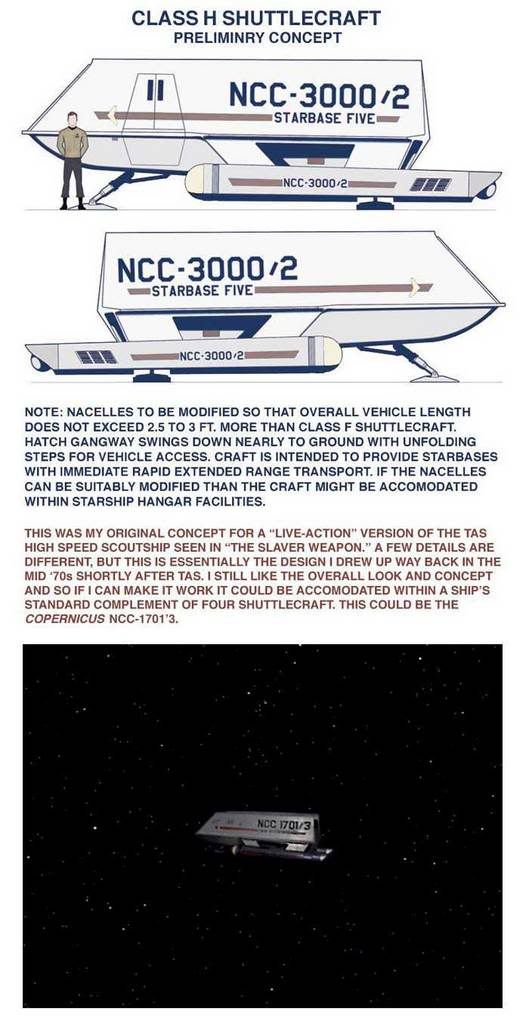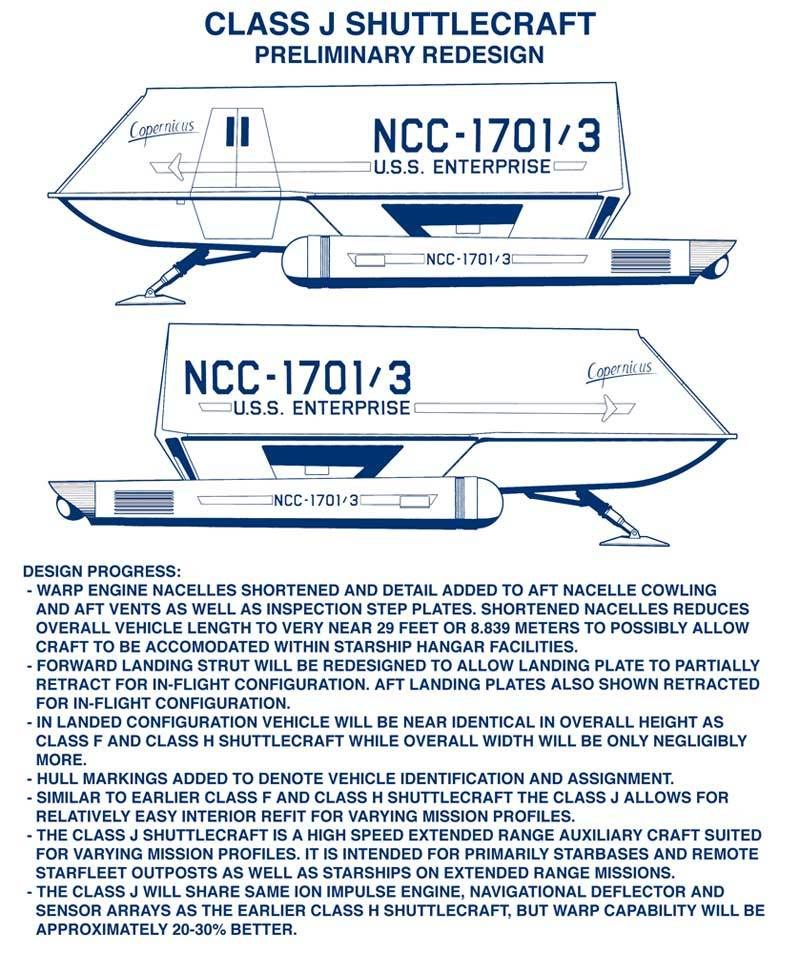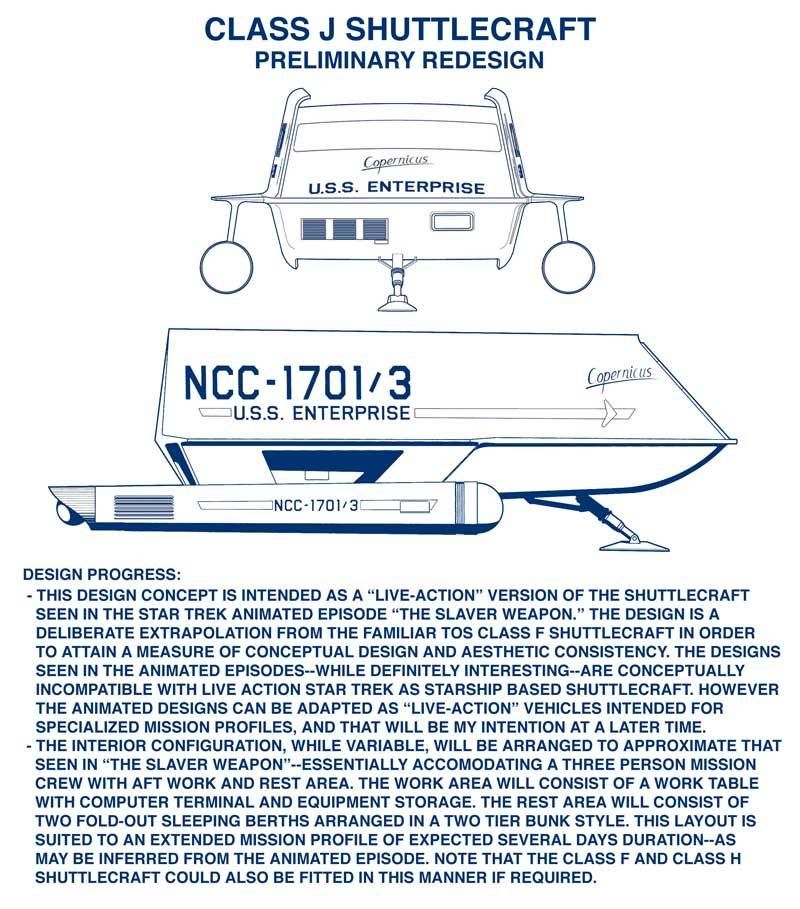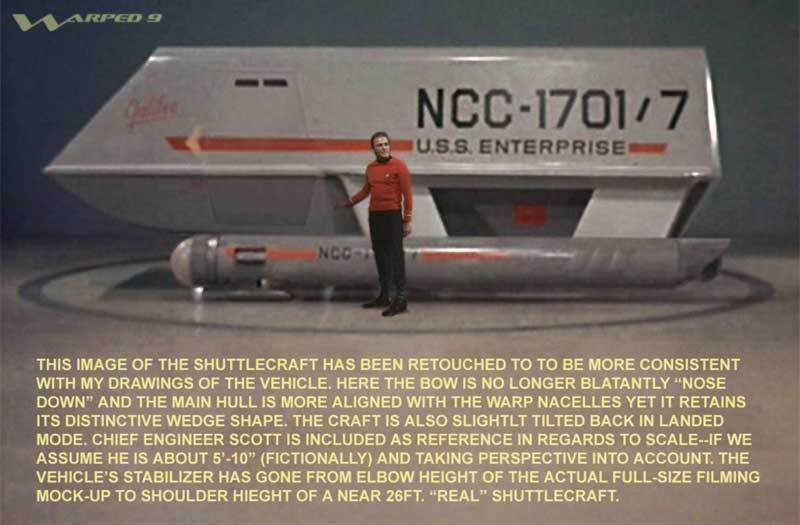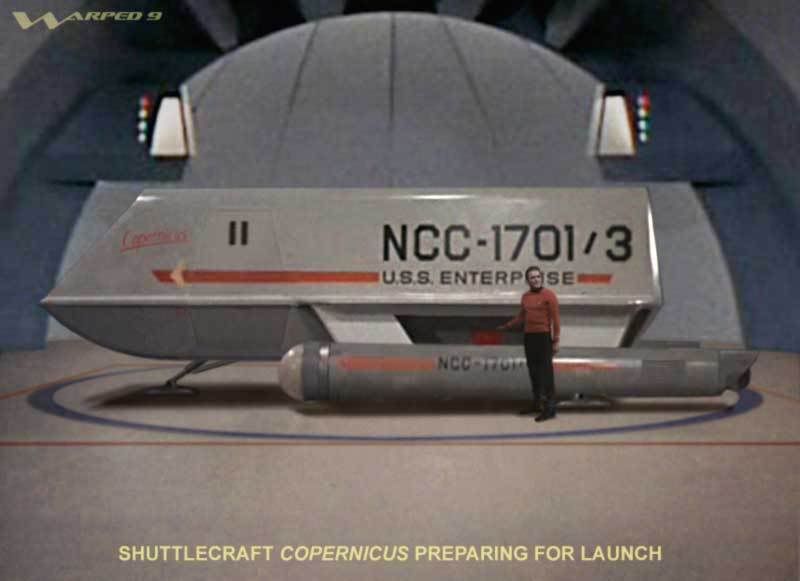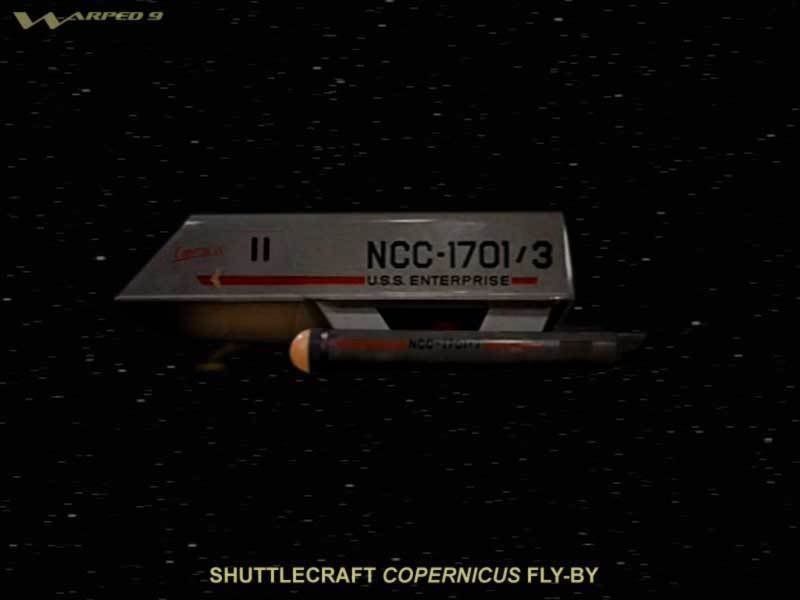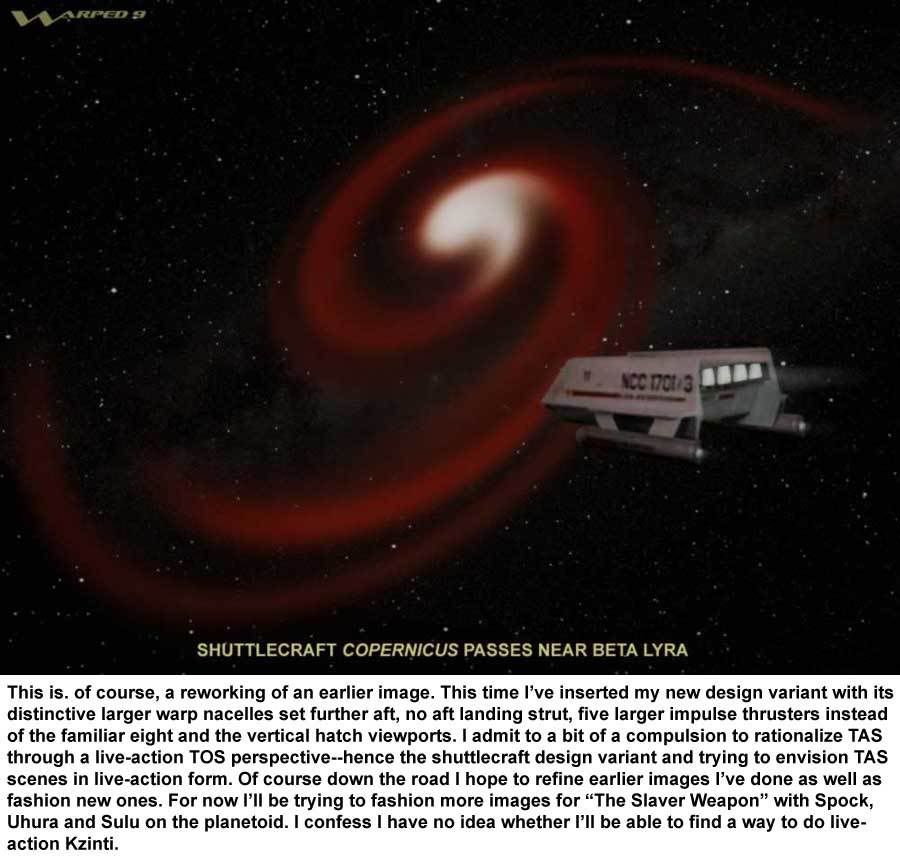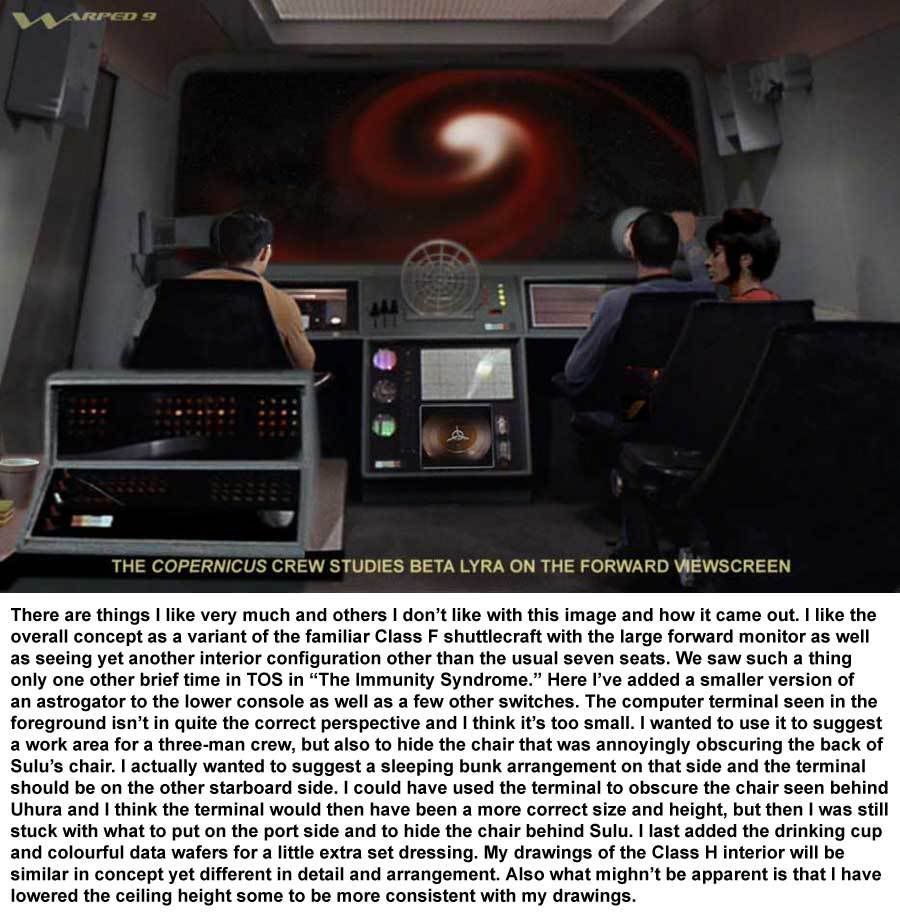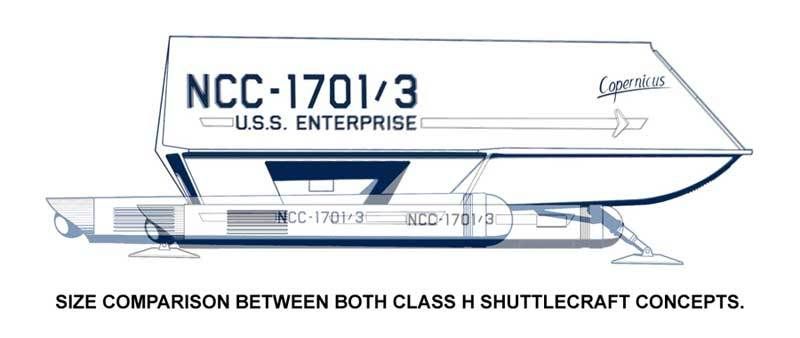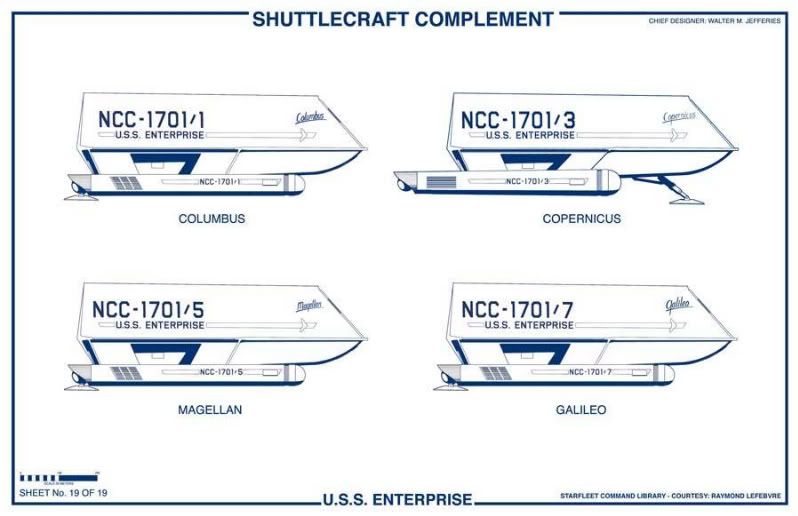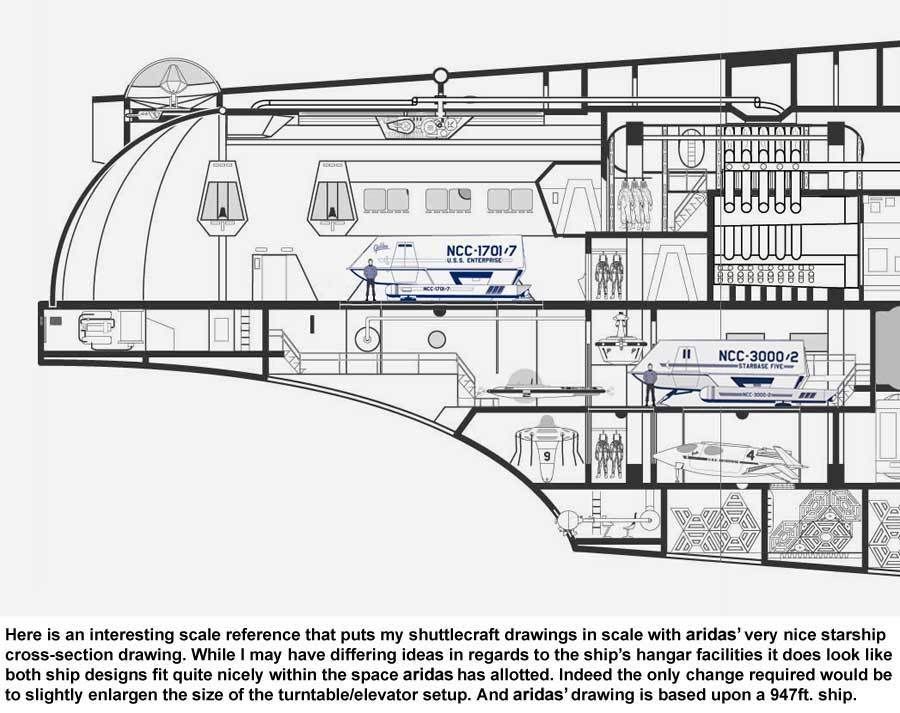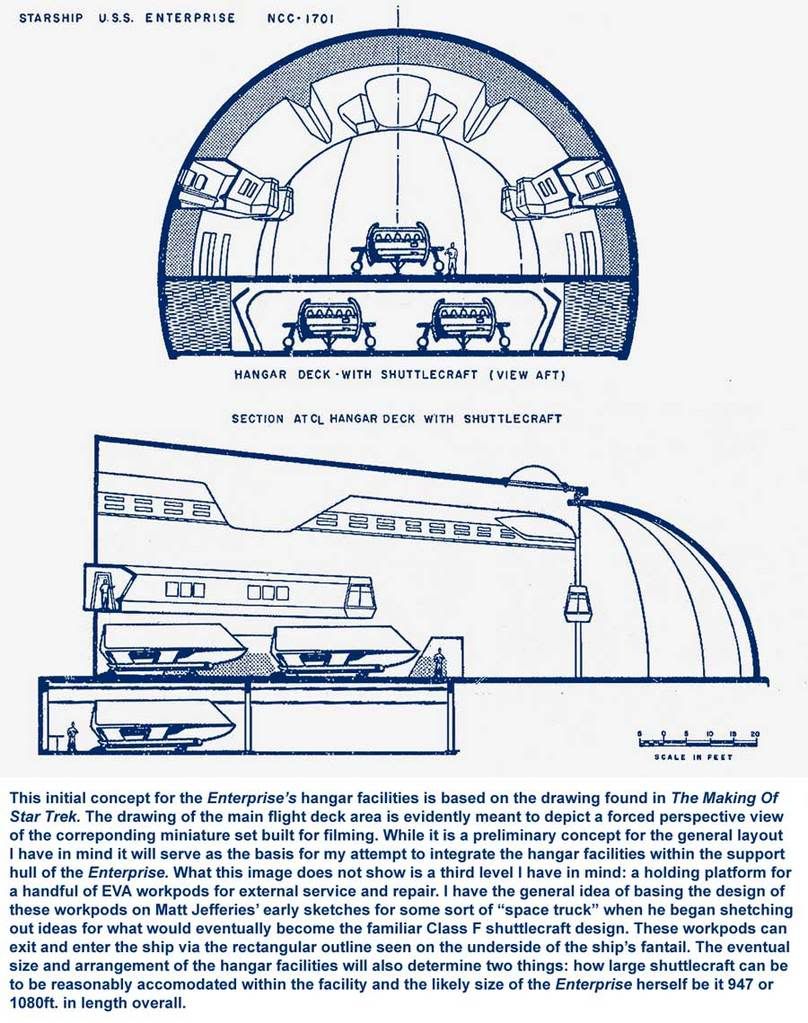This little project began rather simply. The objective was to fashion a believable “realistic”
Star Trek TOS shuttlecraft that integrated the three differing versions of the vehicle seen onscreen: the full-size filming mockup, the full-size filming interior set and the “flying” filming miniature. This type of project has been attempted before with varying results primarily because different individuals bring different mindsets and talents to the effort.
To some extent I felt the full-size exterior mockup was closest to the final form of the exterior design although I felt the mockup looked somewhat worn or damaged with its blatant “nose down” attitude. Of course that merely reflected what could be clearly seen on the mockup’s construction drawings as shown by Phil Broad on his cloudster.com website. Meanwhile the filming miniature showed no such “nose down” attitude and so I chose to retain the full-size mockup’s look although modified to be less extreme. My objective was an integrated design that looked very close to the full-size and miniature mockups. Now the craft does retain something of a pitched forward look yet without looking extreme or damaged.
Integrating the full-size exterior and interior set was more challenging. If you opt for scaling up the exterior to accommodate the interior set as seen onscreen then you end up with a very sizable craft of about 31ft. long. The design of the TOS shuttlecraft doesn’t really lend itself to that size for two basic reasons: the step height to enter or exit the craft becomes very awkward and the vehicle itself becomes too large to be properly accommodated within the
Enterprise’s hangar deck, never mind four such craft. If you opt to retain the apparent size (about 22ft.) of the exterior mockup seen onscreen than you soon realize it’s impossible to have an interior even remotely resembling what was seen onscreen—it’s simply much too small.
Initially I tried to retain the interior as seen onscreen, but soon appreciated that the corresponding sizeable exterior was simply too unwieldy to fit properly into the
Enterprise’s hangar. And so I went back and studied the episodes again as well as whatever other reference material I could review. I realized that the exterior and interior mockups seen onscreen were actually production compromises to facilitate filming rather than what Matt Jefferies may well have intended for his design. The exterior mockup, out of necessity, was scaled to be moved around and even transported without too much difficulty while the interior set was given a standing height ceiling to facilitate lighting and filming interior scenes. But there are clues right onscreen that suggest what Matt Jefferies might really have had in mind.
Firstly the exterior mockup’s pitched forward look. It might be that Matt Jefferies had the idea of filming the mockup mostly from side and rear angles and so the pitched forward look would create some illusion of extra length and height. This is an old trick in film and television production to create the illusion of size and so why couldn’t MJ have used it here? This notion is bolstered by the fact that all other drawings of the vehicle other than the construction plans do not show a pitched forward design. Secondly there are inconsistencies in the interior set: why are the chairs and controls apparently set lower than usual or necessary and why are the actors crouching slightly when the standing height ceiling allows them not to? Is it possible that they were trying to suggest the interior was smaller than it actually was?
This was the thinking I followed and consequently I elected to scale down the craft as much as possible to hopefully reach an accepted compromise—an exterior that could be more easily accommodated within the starship’s hangar deck and an interior that allowed for the events depicted and still look near exactly like that onscreen and supporting the idea of a smaller interior the actors and set dressing seem to be trying to convey. In the end I arrived at a vehicle a smidgen under 26ft. in length overall. And then a rather curious realization arose when I measured the main hull without the added length of the nacelles and aft landing gear—the main hull just happened to be near exactly 24ft. By pure chance I might have hit upon an obscure measurement that could rationalize a spoken reference to “a twenty-four foot shuttlecraft” as spoken by Kirk onscreen.
My design is by no means definitive. The results I arrived at were based on my particular reasoning and aided by the sharp insights of many other people. But I will say that my design does integrate all three versions of the TOS shuttlecraft as seen onscreen into a integrated “realistic” whole while in most respects still looks near exactly like what was seen onscreen both inside and out. The distinction is that I am trying to depict an integrated whole vehicle as opposed to strictly duplicating filming mockups and sets.
During this exercise I was also thinking about tackling the shuttlecraft seen in
Star Trek’s animated series. Specifically the three disparate vehicles seen in the episodes “The Slaver Weapon,” “Mudd’s Passion” and “The Ambergris Element.” Way back in the mid ‘70s when I was first watching TAS I soon realized the new shuttlecraft designs, while intriguing, were shown much too large to be accommodated within the
Enterprise’s hangar. Of course the question arises: why didn’t the animators simply use the existing TOS shuttlecraft design? I believe the answer lies in the very nature of the series being animated and thus allowing anything imaginable to be depicted without any budgetary concerns in actually building it—you just draw whatever you want. While commendably ambitious I feel that in some respects the animators and writers might have been a little too quick to ignore what TOS had already established. (It must be said that if you scrutinize the panning shot of the ship’s hangar area in TAS you can see a vehicle that does bear some resemblance to the familiar TOS shuttlecraft)
Mind you, though, there was some precedence for what they did. In first season TOS we saw a rather simple Main Engineering interior set. This set was greatly expanded for the second season. But now we had two rather different looking Engineering sets. How is that explained? A simple explanation is to accept that the expanded set we saw in 2nd and 3rd season is how the set was supposed to be all along. However, some have suggested a more elegant explanation that we are actually seeing two different locations: the set seen in 1st season is the Engineering facility located at the aft end of the main hull (purportedly for the event the main saucer hull must separate from the rest of the ship) and the set seen in the latter seasons was Main Engineering located down in the secondary support hull. A little creative thinking made sense of an apparent onscreen contradiction.
Of course this isn’t the end of the Main Engineering issue because in TAS they expanded and redressed the set yet again. Now how could that be rationalized? You can either gloss over it and accept that that was what Main Engineering was always supposed to look like or you can assume additional changes were fitted to it at some point. There is, however, a third option and one that I’ve elected to follow as general practice where applicable. I try to look at what we see in TAS through a TOS “live-action” perspective. If what I’m seeing can be accommodated with that already established in TOS then fine. But if not then I resort to the notion that TAS is essentially
a storyboard of live-action episodes. What that means is that some of the things seen in TAS cannot work as shown “realistically” and so they are just storyboard concepts that must be adapted for the more realistic TOS universe. Of course this brings us back to the three disparate shuttlecraft in TAS and how can they be rationalized within the context of “realistic” TOS.
Firstly I must say that I like the idea of variant shuttlecraft designs. It makes the
Star Trek universe more complex and more interesting. That said I feel I must still apply my perspective of TOS “realism” to the issue to rationalize what we see onscreen. In “The Slaver Weapon” and “Mudd’s Passion,” we see vehicles that differ greatly from the familiar TOS shuttlecraft for no truly justifiable reason. In both instances the TOS shuttlecraft would serve perfectly well for the events depicted. However, are there any clues as to why these vehicles should be different from the TOS craft?
In “The Slaver Weapon” the vehicle shown appears to be a rather rakish looking craft with starship like warp nacelles. This could suggest a craft meant to be a fast long-range vehicle. This seems supported by the fact the
Enterprise is nowhere nearby to aid the shuttlecraft’s crew in their encounter with the Kzinti. The markings on the craft clearly identify it as originating from the
Enterprise and not borrowed from Starbase 25. And finally there is the spoken reference by Spock in his mission log stating the
Copernicus being an
“Enterprise shuttlecraft.” Acknowledging those clues we’re now faced with the fact that the large vehicle shown cannot be properly accommodated within the starship’s hangar facility. We must also ignore the fact that TAS depicted an
Enterprise hangar facility that was oversized and impossibly larger than previously seen in TOS.
If you ignore the vehicle’s markings you could rationalize that for whatever reason Spock, Sulu and Uhura have borrowed it from Starbase 25. However, it’s harder to ignore Spock’s spoken reference and as we’ve already noted there’s no reason a standard TOS shuttlecraft couldn’t have served for what we saw onscreen. And so could the TOS
Enterprise have had variant shuttlecraft for different purposes and we just never saw them before? Why not? Of course now we hit the real problem of accommodating a fast long-range craft within the starship’s hangar as well as the remaining standard shuttlecraft.
In years past I’ve tried repeatedly to scale down the shuttle seen in “The Slaver Weapon” to be more consistent in size with the TOS shuttlecraft and failed repeatedly. It isn’t just a matter of size, but also trying to retain the overall look of the design—it’s too long in relation to height. The only recourse was to alter the proportions and end up with a rather stubby looking design that bears little resemblance to the ship seen onscreen. The results were rather disappointing overall. And so my recourse was to approach the issue differently: given time and money how could TOS have depicted such a vehicle and still fit it in the
Enterprise’s hangar deck? I admit a bias here, but I felt strongly that to be aesthetically consistent with what had already been established a new shuttlecraft would be a variation of the already familiar TOS design. What we saw in TAS simply must be a storyboard concept that would had to have been adapted to be done live-action. However, wherever possible I hoped to include features that could be conceptual bridges between the TAS ship and a new and previously unseen TOS design.
The most readily recognizable feature that could be adapted into the new design would be the starship like and distinctively tapered warp nacelles. This approach, however, necessitates setting the nacelles further aft and rethinking the hatchway setup to maintain a reasonable entry/exit step height. Fitting these nacelles to the familiar shuttlecraft isn’t really a problem aesthetically, but it unavoidably results in added length to the overall size of the craft. The new design is 29ft, three feet more than the Class F design. The new design admittedly looks nothing like the TAS ship--that was unavoidable—but it does look credibly consistent with everything else in TOS. For me, though, the real issue is if that extra three feet in length is a deal breaker or not. I devoted a lot of time and effort to get the Class F design down to a manageable size yet here we are trying to accommodate a larger vehicle again.
Although it might be possible to accommodate a 29ft shuttlecraft an even simpler solution would be to assume the new design differs primarily in its systems rather than in overall appearance. This is little different from having two near identical looking cars only one has a performance tuned powerplant and suspension, and leaving us with a ship of manageable size within the
Enterprise’s hangar facility. As much as I like my design with larger warp nacelles I find this latter approach a more elegant solution. I could still accept my other design as a sort of 23rd century runabout designed for remotely located starbases and one that can be temporarily taken within a starship hangar. In counterpoint, though, that extra three feet in length and perhaps no more than a foot extra width might well not be an insurmountable problem. And if so then it would be quite feasible to have a shuttlecraft variant stored aboard ship that looks distinctly different than the familiar Class F.
The shuttle seen in “Mudd’s Passion” is perhaps the most intriguing of the three new designs. While somewhat sleek it also seems to suggest a sturdily built craft perhaps intended for unusually hostile environments. It also has
Enterprise markings on the hull although once again you could ignore this and assume the craft is “on loan” for an unspecified mission. Still there is nothing in this episode that argues a familiar TOS shuttlecraft couldn’t have served for the events depicted. This design is also much too large to be properly accommodated in the
Enterprise hangar and I’ve also failed in scaling it down satisfactorily. In the end I simply accept that if done live-action then we would simply have seen a familiar TOS shuttlecraft used here.
Now in both cases of “The Slaver Weapon” and “Mudd’s Passion” I’ve rationalized what we see through a TOS perspective. However, those new designs are still intriguing enough that I’d like to reconcile them within the TOS universe. My solution is to adapt the designs into something a bit more “realistic” while still retaining their general appearance and as specialized starbase based vehicles.
Finally we come to the design seen in “The Ambergris Element.” The vehicle seen there is not only different looking, but it operates in a manner different than anything seen before. This is an
aquashuttle, a vehicle intended to operate within an aquatic environment as well as the vacuum of space. Suffice to say that there is obviously no way a TOS type shuttlecraft could be used in this manner. Furthermore this vehicle is once again too large to be reasonably accommodated within the
Enterprise’s hangar area.
If we also recall that the
Enterprise’s mission is to explore predominantly Earth like planets we can accept that periodically they may well also explore aquatic environments on some of those planets. But since exploration of aquatic environments is an occasional rather than routine practice then we could assume that an aquashuttle could be loaned out to a starship for specialized missions. With that assumption then the usual restrictions of vehicle size needn’t be so rigid. The aquashuttle need only be sufficiently scaled to fit temporarily within a starship’s flight deck area until it can be returned to its base of origin. Its eventual size can also take into account that this vehicle likely isn’t designed for prolonged flights in space. It is strictly a short-range orbit-to-surface and return craft.
The apparent design of the aquashuttle actually doesn’t look particularly aqua-dynamic. The TAS animators and writers would have done better to mimic something akin to the
Proteus submarine seen previously in the 1966 feature film
Fantastic Voyage. That said I believe it’s possible to adapt the aquashuttle into something a little more TOS “realistic” while still retaining the general look of the animated design.
There are some who sidestep the whole issue of reconciling TAS with TOS by simply ignoring the animated episodes as not “real”
Star Trek. But in many respects TAS has for a long time been accepted by many as just as authentic if not more so than any Trek spin-off that has followed since. Furthermore various elements of TAS have been referenced or even adapted into live-action Trek over the years. Admittedly I don’t like the idea of wholly ignoring TAS since I do feel it is more consistent and more authentic than the live-action Treks that have since followed. For that reason I try to accept TAS and elements of it as is unless it badly contradicts what TOS has already established. And in those cases than I simply reason that TAS is showing us an animated storyboard representation in place of what we would have actually seen in live-action
Star Trek.
This has been a rather protracted bit of exposition, but in a roundabout way I am soliciting opinions particularly from those of you whose insight I’ve greatly appreciated along the way and during this project.
And so the options are:
(A) A Class H variant that differs only in its systems upgrades but otherwise is sized exactly like the earlier Class F. (this is the simplest alternative)
(B) A Class H variant that is adapted from the existing Class F design yet looks distinct and is slightly larger. (if it can be accommodated within the Enterprise’s hangar facilities then this is my preferred alternative)
(C) An adaptation of the scoutship seen in TAS’ “The Slaver Weapon” and based on the assumption that this vehicle was on loan from a starbase (and consequently ignoring that the craft had Enterprise markings on its hull and Spock’s spoken reference).
(D) None of the above and ignoring TAS altogether.
Thoughts anyone?

